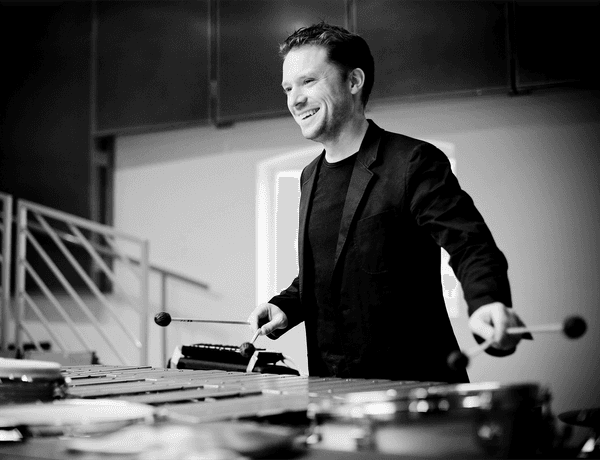Bernstein & Elfman

Full programme
- Bernstein, Candide: Overture (5mins)
- Elfman, Percussion Concerto (31mins)
- Weill, Lady in the Dark: Symphonic Nocturne (17mins)
- Bernstein, West Side Story: Symphonic Dances (24mins)
Performers

Fabien Gabel
Conductor
Colin Currie
Percussion
Introduction
I’m delighted to be rejoining forces with the marvellous CBSO in presentation of my brand new and brilliant Percussion Concerto, written for me by Danny Elfman.
We felt that an enticing combination of music for stage and screen, from the finest writers in this ‘American’ style, would be a thrilling context for the new concerto. As such, the great genius Leonard Bernstein (recently brought superbly to life by Bradley Cooper in the film Maestro) fills out the remainder of the programme, alongside music from the Broadway musical The Lady in the Dark by Kurt Weill. That show also went on to be a feature film, starring none other than Ginger Rogers!
All of these composers deliver scores of sweeping and cinematic splendour, with soaring melodies and catchy themes. This is abundantly so in the concerto, which delivers all of Elfman’s trademark drama and quirkiness in a work of exceptional vigour and virtuosity for the soloist. The concerto furthermore pays homage to two of Danny’s favourite composers and key influencers - Bartók (by way of instrumentation choices, featuring strings, percussion and celesta) and Shostakovich (the second movement uses this composer’s famously thematic initials, D.S.C.H., as musical material).
West Side Story is perhaps the most venerated musical of all time, and its numerous adaptations are perhaps most famously consolidated in its ‘Symphonic Dances’, which allow the orchestra to really go wild as well as deeply lyrical. ‘Candide Overture’, by turns witty and wistful, is our curtain opener.
We are certain you will enjoy this high-octane trip from stage to screen to the concert hall - but buckle up! We will be raising the roof of Symphony Hall tonight!
Colin Currie
Percussion Soloist
Programme Notes
Driving rhythms and wide-screen sounds – the music that made America! You’ve already heard of Danny Elfman: the film composer behind The Simpsons, Batman and Edward Scissorhands. But tonight, discover another side of his genius, as Colin Currie (as one critic put it, “the world’s finest and most daring percussionist) plays Elfman’s Percussion Concerto. Electrifying stuff: and conductor Fabien Gabel will raise the voltage even higher with symphonic showstoppers from Bernstein’s Candide and West Side Story.
Candide: Overture
Leonard Bernstein (1918 - 1990)
Leonard Bernstein was one of music’s great multi-taskers. For example, between 1954 and 1956 he wrote film score to On the Waterfront, turned some of its music into a concert suite, composed a violin concerto, gave a televised lecture on Beethoven’s Fifth Symphony, conducted Maria Callas at La Scala and fashioned a light opera out of an eighteenth-century French satire. (Alongside, he was devising a project – initially called ‘East Side Story’ – that would soon preoccupy him further.)
The light opera was Candide, begun in 1954 but not completed until 1956, Bernstein being periodically distracted by all of the above. The work as a whole, including its bustling Overture, is as eclectic and wide-ranging as Bernstein’s career.
Opening with an assertive fanfare from the brass, it segues instantly into a scurrying string melody, then a brisk canter through several numbers from the musical itself, some of them (such the sweetly lyrical ‘Oh happy we’) appearing several times. The music conjures up an elegant, eighteenth-century ambience – some passages sounding almost like Mozart – filtered through Bernstein’s trademark sass and rhythmic wit. It concludes with a sparkling montage of melodies heard throughout.
The operetta itself had a disastrous premiere ran for only two months. It was heavily revised, then overhauled again and again over the subsequent decades. The Overture, however, was a hit from its first concert performance and has remained a perennial favourite.
Percussion Concerto
I. Triangle
II. D.S.C.H.
III. Down
IV. Syncopated
Danny Elfman (b. 1953)
Expect some rearrangement of the furniture for Elfman’s Percussion Concerto, in which a solo percussionist comes to the foreground with a fabulous array of instruments including a waterphone, piccolo snare drum and a metal ‘gizmo’ (which according to the scores produces ‘a variety of enticing metallic sounds’).
Elfman – like Bernstein, a musical polymath – is perhaps best-known as a film composer (scoring all four Men in Black films, the theme tune to The Simpsons, and working with Tim Burton on titles such as Edward Scissorhands and Beetlejuice). But he has maintained a wide range of musical interests alongside, such as writing songs for his experimental band Oingo Boingo and keeping up a regular roster of concert works, including a violin concerto for Sandy Cameron in 2017.
The vibrant, endlessly inventive Percussion Concerto is structured in four movements. The outer two are brilliantly rhythmic and fast-paced, while the inner two are more reflective, especially the soulful third, subtitled ‘Down’. The first movement is called ‘Triangle,’ not referring to the actual triangle but the spatial configuration between the foregrounded soloist and the two percussionists either side at the back of the orchestra, both of whom also command a huge range of instruments. The soloist generates an extraordinary variety of sounds and effects in constant dialogue with the percussion section, or with shuddering strings, or battling for supremacy with the piano. There is a magical – perhaps Scissorhands-ish – sparkle to a recurring wistful passage for sliding strings and marimba.
The second movement is dedicated to Shostakovich and deploys the Russian composer’s ‘personal’ motif: D-S-C-H (or D, E flat, C, B), short for Dmitri Schostakovich. The shape of the theme first appears in the vibraphone, then reappears as a refrain throughout. The movement begins and ends in a sparse, sometimes eerie texture; in between is a busier, more urgent exchange of rhythms between percussionists and pianist.
The third movement is highly atmospheric, and while more complex musically than the others has a beguiling, intimate quality, with a lengthy solo for the ethereal celeste and an appearance by the waterphone in the closing bars.
The fourth movement, by total contrast, is described by Currie as ‘a humdinger’ (also as a ‘beezer’ and a ‘roof-raiser’), with the soloist given barely any time to move away from the vibraphone. Expect the roof to be duly raised in the blistering gallop to the finish line.
Lady in the Dark: Symphonic Nocturne
Kurt Weill (1900 - 1950)
(arr. Robert Russell Bennett)
Kurt Weill is another composer whose music featured both on Broadway and in the concert hall. His career began in his native Germany, where along with other left-leaning artists he had put on satirical musicals such as The Threepenny Opera (featuring the famous ‘Mack the Knife’) and The Rise and Fall of the City of Mahagonny (known best for the ‘Alabama Song’). In common with many Jewish European artists he left Nazi Germany in 1933 for the United States, and within a few short years managed not only to learn about and adopt a new, specifically American style in his musicals, but create an absolute smash-hit with his 1940 Lady in the Dark with lyrics by Ira Gershwin. It dispelled any doubts Weill might have had about whether – as writer Foster Hirsch put it – he could ‘pass [as] a Broadway composer able to handle a homegrown idiom.’
The subject-matter of Lady in the Dark might not appear to lend itself to ‘smash hit’ status. It is about a woman named Liza undergoing psychotherapy to uncover the root of a hidden trauma, symbolised by a tantalising fragment of melody she cannot place (which turns out to be the song ‘My Ship’). Much of the drama takes place inside Liza’s dreams. In the Symphonic Nocturne, arranged by Robert Russell Bennett, ‘My Ship’ plays a prominent role. Its beautiful, memorable tune opens the suite over gently undulating strings, followed by the jaunty ‘Girl of the Moment’. Other melodies from the show appear in swift succession, ending with the swinging jazz number ‘Jenny made her mind up’ a cautionary tale of single-minded mayhem (the original lyrics of which are well worth seeking out).
West Side Story, Symphonic Dances
I. Prologue
II. "Somewhere"
III. Scherzo
IV. Mambo
V. Cha Cha
VI. Meeting Scene
VII. "Cool" Fugue
VIII. Rumble
IX. Finale
Leonard Bernstein (1918 - 1990)
Bernstein composed his most famous work, West Side Story, alongside and following Candide. It was, fortunately, considerably more successful than the earlier work, lasting for 732 performances in its first run. An Oscar-winning film was made of it in 1961 (more recently in 2021). Its popularity and perpetual acclaim and rediscovery by subsequent generations is perhaps down to its clever, punchy updating of Romeo & Juliet. But mainly, arguably, it is due to Bernstein’s irresistible score: fiercely rhythmic, tenderly lyrical and – as the composer himself said looking back in 1984 – ‘so funky’.
The Symphonic Dances use nine numbers from the show, mainly concerned with gang rivalry rather than the romance between Tony and Maria (although the melody of the song ‘Maria’ is the same as the opening three notes of the Prologue, and features similarly in the Cha-cha movement). The Prologue is full of snap and crackle as the two gangs attempt to seize territory from each other, followed by a wistful counterpoint in Somewhere which imagines a world away from all this. The central movements include the famous Mambo, the vigorous - bordering on violent - dance-off at the gym. After the more delicate Cha-cha Bernstein demonstrates his composer’s chops in Cool, an elaborate fugue in a slinky jazz style. The Rumble is suitably melodramatic, while the final movement is a devastating rendering of Maria’s song ‘I have a love’, concluding with a tolling bass and a chillingly unresolved final note.
© Lucy Walker
Featured image © Marco Borggreve